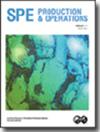Large-Scale Experiments on Slug-Length Evolution in Long Pipes
IF 1.3
4区 工程技术
Q2 ENGINEERING, PETROLEUM
引用次数: 1
Abstract
We present a unique set of two- and three-phase slug-flow experiments conducted in a 766-m-long, 8-in. pipe at 45-bara pressure, using Exxsol™ D60 fluid (ExxonMobil Chemical, Houston, Texas, USA) as the oil phase and nitrogen as the gas phase. The first one-half of the pipe was horizontal, while the second one-half was inclined by 0.5°. A total of 10 narrow-beam gamma densitometers were mounted on the pipe to study flow evolution, and in particular slug-length development. The results show that the mean slug length initially increases with the distance from the inlet, but this increase slows down, and the mean slug length typically reaches a value between 20 and 50 diameters at the outlet. At low mixture velocities (<3 m/s), the slug-length distributions tend to be extremely wide, sometimes with standard deviations approaching 100%. The longest slugs that we observed were more than 250 pipe diameters (50 m). At higher mixture velocities (>3 m/s), the slug-length distributions are in general narrower. The effect of the water cut (WC) on the slug-length distribution is significant but complex, and it is difficult to establish any general trends regarding this relationship. Finally, it was observed that slug flow often requires a very long distance to develop. Specifically, in most of the slug-flow experiments, the flow regime 57 m downstream of the start of the horizontal section was not slug flow.长管道段塞长度演化的大规模实验研究
我们提出了一套独特的两相和三相段塞流实验,在766米长,8英寸。在45 bara压力下,使用Exxsol™D60流体(ExxonMobil Chemical, Houston, Texas, USA)作为油相,氮气作为气相。管道的前半段是水平的,后半段倾斜0.5°。总共有10个窄束伽马密度计安装在管道上,以研究流动演变,特别是段塞长度的发展。结果表明,随着与进口的距离增加,平均段塞长度开始增加,但增加速度逐渐减慢,平均段塞长度通常在出口达到20 ~ 50个直径之间。在低混合速度下(3 m/s),段塞长度分布通常较窄。含水率(WC)对段塞长度分布的影响是显著而复杂的,很难建立这种关系的一般趋势。最后,观察到段塞流通常需要很长的距离才能形成。具体来说,在大多数段塞流实验中,水平段起始下游57 m处的流态不是段塞流。
本文章由计算机程序翻译,如有差异,请以英文原文为准。
求助全文
约1分钟内获得全文
求助全文
来源期刊

Spe Production & Operations
工程技术-工程:石油
CiteScore
3.70
自引率
8.30%
发文量
54
审稿时长
3 months
期刊介绍:
SPE Production & Operations includes papers on production operations, artificial lift, downhole equipment, formation damage control, multiphase flow, workovers, stimulation, facility design and operations, water treatment, project management, construction methods and equipment, and related PFC systems and emerging technologies.
 求助内容:
求助内容: 应助结果提醒方式:
应助结果提醒方式:


